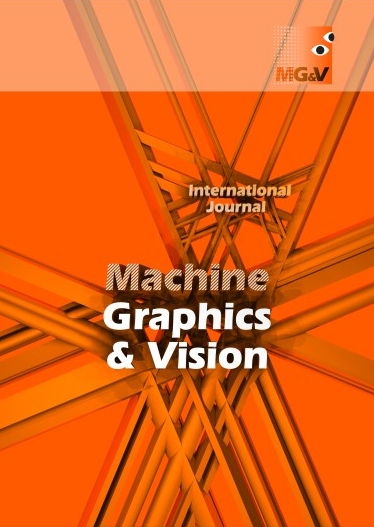Main Article Content
Physics-based optical flow models have been successful in capturing the deformities in fluid motion arising from digital imagery. However, a common theoretical framework analyzing several physics-based models is missing. In this regard, we formulate a general framework for fluid motion estimation using a constraint-based refinement approach. We demonstrate that for a particular choice of constraint, our results closely approximate the classical continuity equation-based method for fluid flow. This closeness is theoretically justified by augmented Lagrangian method in a novel way. The convergence of Uzawa iterates is shown using a modified bounded constraint algorithm. The mathematical well-posedness is studied in a Hilbert space setting. Further, we observe a surprising connection to the Cauchy-Riemann operator that diagonalizes the system leading to a diffusive phenomenon involving the divergence and the curl of the flow. Several numerical experiments are performed and the results are shown on different datasets. Additionally, we demonstrate that a flow-driven refinement process involving the curl of the flow outperforms the classical physics-based optical flow method without any additional assumptions on the image data.
Article Details
P. Altomare, S. Milella, G. Musceo. Multiplicative Perturbation of the Laplacian and Related Approximation Problems, Journal of Evolution Equations, 771-792, 2011. https://doi.org/10.1007/s00028-011-0110-6. (Crossref)
G. Aubert, R. Deriche, P. Kornprobst. Computing Optical Flow via Variational Techniques, SIAM Journal of Applied Mathematics, 60:156-182, 1999. https://doi.org/10.1137/S0036139998340170. (Crossref)
H. Brezis. Functional Analysis, Sobolev Spaces and Partial Differential Equations, Springer, 2011. https://doi.org/10.1007/978-0-387-70914-7. (Crossref)
T. Corpetti, E. Mémin, P. Pérez. Estimating Fluid Optical Flow, Proceedings of the 15th International Conference on Pattern Recognition (ICPR2000), 3:1033-1036, 2000. https://doi.org/10.1109/ICPR.2000.903722. (Crossref)
T. Corpetti, D. Heitz, G. Arroyo, E. Mémin, A. Santa-Cruz. Fluid Experimental Flow Estimation based on an Optical Flow Scheme, Experiments in Fluids, 40:80-97, 2006. https://doi.org/10.1007/s00348-005-0048-y. (Crossref)
X. Chen, P. Zillé, L. Shao, T. Corpetti. Optical Flow for Incompressible Turbulence Motion Estimation, Experiments in Fluids, 56:8, 2015. https://doi.org/10.1007/s00348-014-1874-6. (Crossref)
P. Eidus, The Perturbed Laplace Operator in a weighted L2 space, Journal of Functional Analysis, 100:400-410, 1991. https://doi.org/10.1016/0022-1236(91)90117-N. (Crossref)
J. Carlier, R. Cemagref. FLUID. Image sequence database. http://fluid.irisa.fr/data-eng.htm (Accessed: December 2023).
J. Carlier. Second set of fluid mechanics image sequences. European project FLUid Image analysis and Description, 2005. https://cordis.europa.eu/project/id/513663.
R. Glowinski, P. Le Tallec. Augmented Lagrangian and Operator-Splitting Methods in Nonlinear Mechanics, SIAM, 1989. https://doi.org/10.1137/1.9781611970838. (Crossref)
D. Heitz, E. Mémin, C. Schnörr. Variational Fluid Flow measurements from Image Sequences: Synopsis and Perspectives, Experiments in Fluids, 48:369-393, 2010. https://doi.org/10.1007/s00348-009-0778-3. (Crossref)
W. Hinterberger, O. Scherzer, C. Schnörr, J. Weickert. Analysis of Optical Flow Models in the Framework of Calculus of Variations, Numerical Functional Analysis and Optimization, 23(1-2):69-89, 2002. https://doi.org/10.1081/NFA-120004011. (Crossref)
B. K. P Horn, B. G. Schunck. Determining Optical Flow, Artificial Intelligence, 17:185-203, 1981. https://doi.org/10.1016/0004-3702(81)90024-2. (Crossref)
T. Liu. OpenOpticalFlow: An Open Source Program for Extraction of Velocity Fields from Flow Visualization Images, Journal of Open Research Software, 5:29, 2017. https://doi.org/10.5334/jors.168. (Crossref)
T. Liu, L. Shen. Fluid Flow and Optical Flow, Journal of Fluid Mechanics, 614:253-291, 2008. https://doi.org/10.1017/S0022112008003273. (Crossref)
A. Luttman, E. M. Bollt, R. Basnayake, S. Kramer, N.B. Tufillaro. A Framework for Estimating Potential Fluid Flow from Digital Imagery, Chaos: An Interdisciplinary Journal of Nonlinear Science, 23:3, 2013. https://doi.org/10.1063/1.4821188. (Crossref)
J. Nocedal, S. J. Wright. Numerical Optimization, 2nd Edition, Springer, 2006. https://doi.org/10.1007/b98874. (Crossref)
C. Schnörr. Determining Optical Flow for Irregular Domains by Minimizing Quadratic Functionals of a Certain Class, International Journal of Computer Vision, 6:25-38, (1991). https://doi.org/10.1007/BF00127124. (Crossref)
B. Wang, Z. Cai, L. Shen, T. Liu. An Analyis of Physics-based Optical Flow, Journal of Computational and Applied Mathematics, 276:62-80, 2015. https://doi.org/10.1016/j.cam.2014.08.020. (Crossref)
J. Weickert, C. Schnörr. A Theoritical Framework for Convex Regularizers in PDE-based Computation of Image Motion, International Journal of Computer Vision, 45:245-264, 2001. https://doi.org/10.1023/A:1013614317973. (Crossref)
R. P. Wildes, M. J. Amabile, A. Lanzillotto, T. Leu. Recovering Estimates of Fluid Flow from Image Sequence Data, Computer Vision and Image Understanding, 80:246-266, 2000. https://doi.org/10.1006/cviu.2000.0874. (Crossref)
T. Liu. OpenOpticalFlow. GitHub repository, 2021. https://github.com/Tianshu-Liu/OpenOpticalFlow (Accessed: December 2023).
Downloads
- Hirak Doshi, Nori Uday Kiran, Nonlinear Evolutionary PDE-Based Refinement of Optical Flow , Machine Graphics & Vision: Vol. 30 No. 1/4 (2021)





